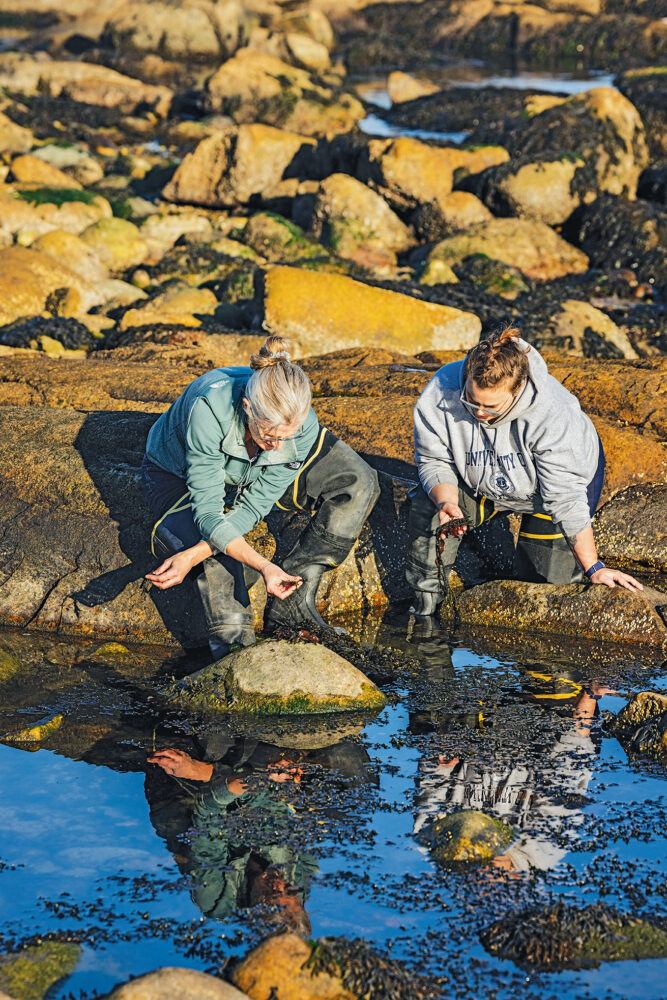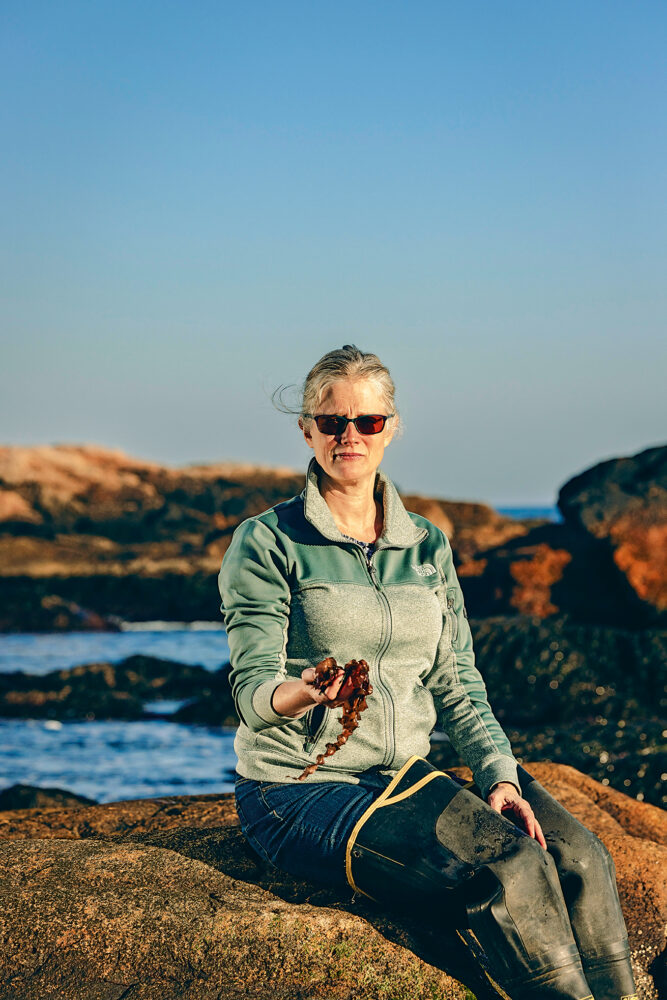A Cleaner and Warmer Narragansett Bay
How is aquatic life adapting?
By Marybeth Reilly-McGreen| Photographs by Jesse BurkeWater quality is improving even as water temperatures are increasing in Narragansett Bay. Scientists are trying to understand what these and other changes mean for bay species.
Looking down at Narragansett Bay from the footpath at the end of Narragansett’s Bass Rock Road, rockweed and kelp gleam gold, olive, and amber in the early afternoon light of an unseasonably warm mid-November day. University of Rhode Island Professor Carol Thornber, a marine ecologist and URI Ph.D. candidate Rebecca Venezia, study the seaweeds in Narragansett Bay. Today, the pair straddle tidal pools, which look like miniature forests upended, gathering fistfuls of seaweed for closer inspection.
Aside from the occasional gull, the only sound is the ambient call-and-response of wind and waves. Narragansett Bay, with 146 miles of habitat supporting 60 species of fish and shellfish, is one of the most thoroughly studied ecosystems on the planet, and marine scientists have been monitoring its water quality, benthic habitats, and fish, phytoplankton, and zooplankton for decades.
Thornber has chosen to look at seaweed—a focus of her research in the bay for more than 20 years—because it’s considered a sentinel species whose sensitivity to changes in its habitat can raise the alarm for researchers.

Thornber hopes that by studying seaweed, scientists will have a clearer picture of what is happening in a changing bay—including temperature increases and other ecosystem-scale dynamics.
A 2021 report by the Narragansett Bay Estuary Program shared the results of a survey of 26 commercial fishermen who shared their firsthand accounts of changes they noticed in the bay. The fishermen reported that in the 1990s, their traps and nets were so overwhelmed by seaweed that individual lobster pots were nearly as big as skiffs, and nets rapidly filled with seaweed soon after sliding off the boat into the ocean. But in the mid-1990s, fishermen began noting the abundance of kelp, a type of seaweed, was declining.
Along with kelp, today, there is even less seaweed. Venezia is going through what Thornber calls “a massive data set” and looking for trends of when people saw lots of drift algae in the 1990s and early 2000s versus the summer surveys that just concluded. What’s going on?
“We know that kelps have declined, which is no big surprise given that they are cold water species and our waters are warming, but we know … that the story is a little more complicated,” Thornber says.
As a foundational ecosystem species, seaweed underpins other marine life. It is a food source, a transportation mechanism, and a habitat for other species. It functions as protection from predators for some species. Thornber has seen a decline in the abundance and types of seaweed typically found in southern New England. Oarweed (Laminaria digitata) is largely absent from local waters, and sugar kelp (Saccharina latissima) isn’t as abundant as it used to be.
Seaweeds aren’t the only organisms in the bay that may be affected by these changes. For the past six years, coastal restoration scientist Heather Kinney has conducted seine surveys of juvenile sport fish in the Providence River Estuary as part of a joint study between The Nature Conservancy and the Rhode Island Department of Environmental Management’s (DEM) Division of Marine Fisheries. A seine is a net capped with buoys on one edge and weighted at the other, allowing it to enclose fish in a circular area. Kinney is collecting information about scup, winter and summer flounder, tautog, and black sea bass, ascertaining how well these juvenile populations are faring in the Providence River and how they’re changing over time.
An important part of Kinney’s work is to identify areas where fish habitat enhancement projects could be established and do so in a way that both offers shore-line protection and nurtures an important food source. “Our goal is to support fish populations by rebuilding salt marshes or installing artificial reefs and improving access for people to get to the healthy sources of fish that aren’t contaminated by pollution,” Kinney says.
Through her surveys, she’s finding that these restoration projects may be providing habitat for different species than in the past. “We’re seeing a lot more black sea bass, especially the juveniles—and not just in the Providence River but also off Block Island. They’re everywhere,” Kinney says. “Mid-Atlantic species seem to be shifting more north as the temperatures are changing. This may also be true for winter flounder, which are also shifting more north, up towards Maine and Canada.”
Changes in Seaweeds in Narragansett Bay Story Map
Venezia’s interactive story map focuses on changes in seaweeds in Narragansett Bay, aiming to inspire future marine scientists by bridging the gap between scientific research and public understanding.
She emphasizes the importance of sharing information about seaweed ecosystems with a broader audience to foster appreciation and stewardship, particularly among younger generations who can become advocates for ocean conservation.
Through outreach to organizations like Save The Bay and schools, Venezia hopes to cultivate a love for the ocean and empower individuals to protect and preserve marine environments.
The northward expansion of southern fish species is also of interest to David Taylor, professor of marine biology at Roger Williams University. Taylor studies the early life history of fishes and their use of Narragansett Bay as a nursery habitat.
“When we’re examining the decline of one species, like winter flounder, for example, it’s not a matter of pointing to one culprit, but trying to assign relative contributions of numerous kinds of stressors the species is facing,” Taylor says.
In addition to being warmer, bay water is also cleaner. Professor of Oceanography Candace Oviatt has been studying Narragansett Bay since the 1960s, first as a graduate student in biological oceanography at the University of Rhode Island’s Graduate School of Oceanography and later as a faculty member.
Since the late 1990s, Oviatt and others have been monitoring the bay with a network of 13 buoys, gathering data and documenting water quality by surveilling water temperature, salinity, and oxygen levels, among other things.

Heather Kinney, coastal restoration scientist, and Sarah Paulson, coastal restoration science technician, use fish trap and seine net surveys to assess coastal environments for The Nature Conservancy.
Prior to the Clean Water Act of 1972, the waters of Narragansett Bay—especially the upper bay—received influxes of untreated sewage, hydrocarbons from storm drains, heavy metals, and chemicals. Source controls in the latter part of the 1900s dramatically reduced these pollutants. Improvements in the form of managed nutrient reduction, which began in Rhode Island in the early 2000s, followed by improvements to stormwater management, have dramatically improved water quality.
Nutrient reductions, which have led to a decrease in plankton in the water column, have made a visible difference.
“I remember, in the case of the Providence River, you were lucky if you could see down half a meter,” Oviatt recalls. “And one meter was absolute darkness. That’s not the case anymore. In the upper or mid-bay, visibility used to be about three meters. Now you can often see to the bottom. So it’s quite a remarkable change.”
Marine ecologist Carol Thornber has focused her research on seaweeds in the bay for more than 20 years because they are considered sentinel species sensitive to changes in their habitat.

Since the advent of the Narragansett Bay Commission Combined Sewer Overflow abatement project, which further reduced the number of bacteria and nutrients entering the bay, more areas of the bay have been open to shellfishing. However, some commercial fishers have publicly expressed fears that these nutrient reductions have caused species’ decline by depriving plankton, which fish and shellfish feed on, of the nutrients that are their own food.
Oviatt cautions against tying species’ biomass, production, or decline to clearer water.
“There are no species that I know of that have left on account of the managed nutrient reduction,” she says. “I don’t think that’s changed the species presence a bit and barely changes the abundance insofar as we’re able to measure it.”
Professor Robinson W. ‘Wally’ Fulweiler, an ecosystems ecologist and biogeochemist at Boston University, has been working with Thornber, studying the changing nutrient dynamics of seaweed in Narragansett Bay. Fulweiler echoes Oviatt’s observations.
“It’s important to remember that the many changes observed in Narragansett Bay occurred well before the management intervention that removed nitrogen from the bay,” Fulweiler says. “For example, long-term phytoplankton records—at least in mid-Narragansett Bay, where we have the most data—show a decline starting in the late 1970s that continues today.
“Narragansett Bay has undergone a variety of major changes over the last 50-plus years—one of the largest has been an increase in water temperature.”
Fulweiler likens anthropogenic effects, that is, out-comes of human activity such as climate change and nitrogen removal, to levers being pulled. In terms of human impact, climate change is a significant lever requiring long-term observation and data collection to understand its effects over time. Nitrogen removal is also a lever—one that is more local and newer. “We are still working out its impact—especially how it fits into the longer-term changes we continue to observe,” Fulweiler says.
“As human beings, we want things clear and straightforward,” Fulweiler adds, “and a natural system just doesn’t function like that.”
Conor McManus, former chief of DEM’s Division of Marine Fisheries, oversaw the scientific study and management of Rhode Island’s marine resources. He echoes the others in saying that the Bay now favors warmer-water species, which is an ecological shift being seen all along the Atlantic seaboard.
But “it’s not clear if those new species fill the same void, fill the same role as the species that have now left,” McManus says. “It’s not clear also from a recreational or commercial or cultural side of things that those species hold the same value.” Scientists get skittish when asked to label change as “good” or “bad.”
They don’t like portraying the bay as improving or worsening. And they aren’t going to weigh in on whether the bay is too clean. Such characterizations are an oversimplification of the ebbs and flows of an ecosystem. That doesn’t mean there aren’t things people can do to try to ensure a healthy ecosystem in the bay for existing species, from seaweeds to fish, birds, and mammals.
Thornber points out that boaters can have a direct impact on preventing the transfer of invasive species to the bay’s waters. Interventions such as cleaning boat hulls and dumping ballast water before moving boats to different regions would limit the introduction of invasive species into the ecosystem, which may help protect native species from displacement, Thornber says.
Another strategy is protecting and preserving coastal habitats such as salt marshes and estuaries, which need higher areas to migrate to as sea level rise continues. Everyone has a stake in the bay’s future, Kinney, of The Nature Conservancy, says. “We want to maintain the species that we have in this area; that’s important, for sure,” she says. “But the more dynamically we can be thinking about how all these changes are going to impact us and impact species, the better.”
Narragansett Bay Estuary Program
This issue is supported by the Narragansett Bay Estuary Program (NBEP), a nonprofit organization led by stakeholders that pursues place-based conservation across the three-state Narragansett Bay region.
With its 30-member partnership, NBEP catalyzes scientific inquiry and collective action to restore and protect the region’s water quality, wildlife, and quality of life.
This issue of 41°N highlights several of the stories and partners driving a 10-year blueprint to realize their vision of clean water and habitat to sustain all who live, work, and play in the Narragansett Bay region.
Contact Us
Telephone: (401) 874-6805
Email: allard@uri.edu
Contributor Guidelines
Please review submission guidelines to be considered. d

